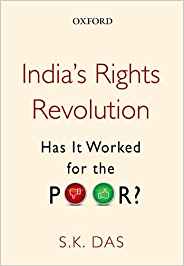The past decade has seen the introduction of a series of rights-based legislations in India, which the author calls a ‘veritable rights revolution’, with the enactment of the Right to Information Act (in 2005), the National Rural Employment Guarantee Act (in 2005), the Forest Rights’ Act (in 2006) and the Right to Education Act (in 2009). As the UPA Government—which introduced all these legislations—is going to polls within a year, this book asks a well-timed and significant question: has this much touted ‘rights revolution’ actually worked for the poor, the very sections of society for whom these rights were intended?
However, despite the author repeatedly posing this question and presenting a detailed account of these legislations, his actual enquiry into their socio-economic and political impact on disadvantaged segments of Indian society (which is meant to be the focus of this book) is very limited—both in terms of the space devoted to it, as well as in its depth. His analysis of whether these legislations have worked for the poor or not is rather simplistic and overlooks the significance of the socio-economic and policy environment within which this rights-based framework has been introduced.

